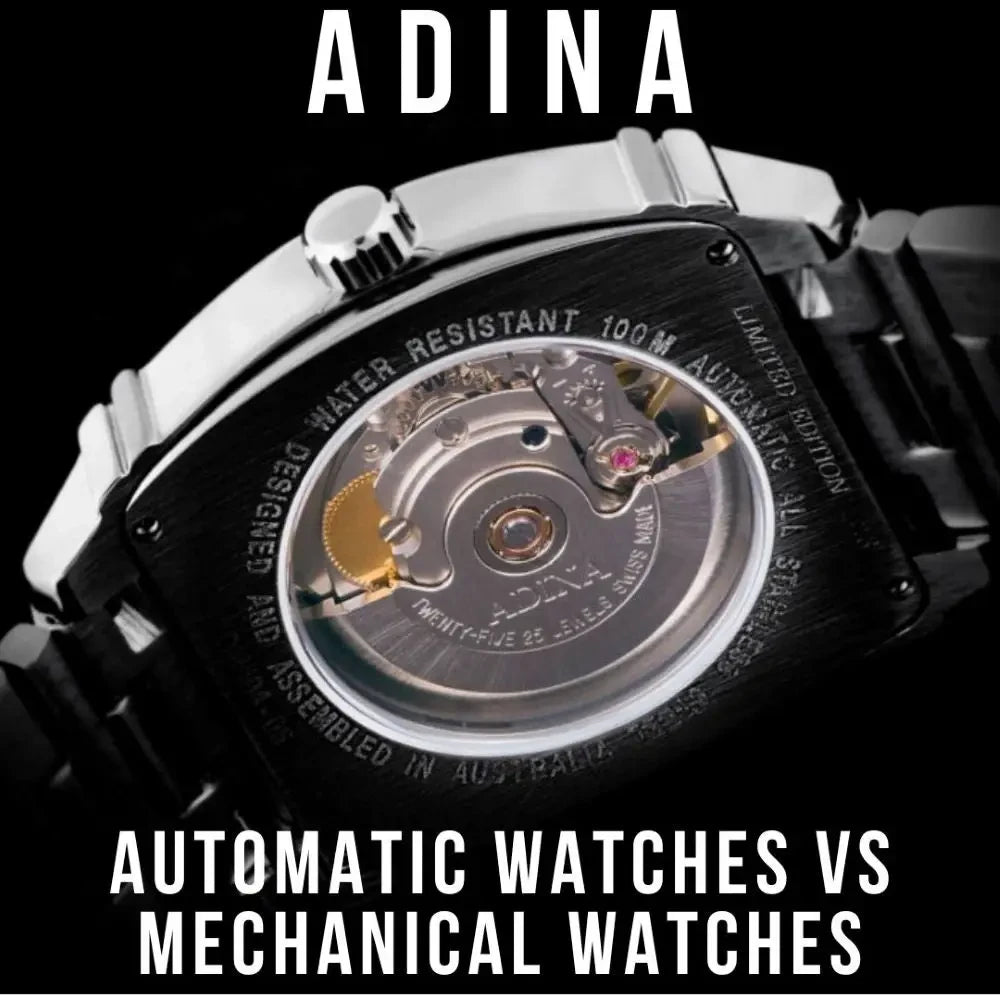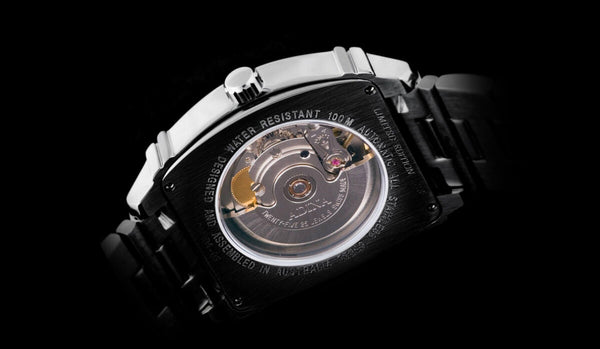Adina Watches and Clocks at Seaspray
Here at Seaspray Jewellery, we love the range of watches and clocks by leading Australian watch and clock manufacturer Adina, who are based in Brisbane, Queensland.
We stock a wide range of Adina's watches and clocks however, if we don't have the exact style you are looking for you, we are happy to order Adina's other styles in for you.
Meanwhile, below is an interesting article from Adina which explains the differences between automatic watches and mechanical watches!

Adina Automatic Watches VS Adina Mechanical Watches
Automatic and mechanical watches are both very traditional timepieces.
Mechanical watches rely on mechanical parts and do not have a battery or electronic components to measure time like our quartz Adina watches. Both mechanical and automatic watches use a complex series of gears, springs, and other mechanisms called complications to set and maintain the correct time. The main difference between these two types of watch movements is the way they are powered.
In this guide, we analyse the differences between the Automatic and the Mechanical Adina Watches and determine how both watch movements measure up against aesthetics, time precision, functionality, and durability.
Before we get into the discussion of Automatic vs Mechanical watches, let us first determine how both versions of the mechanical Adina watches operate. We have to start by acknowledging that both versions of the mechanical watch have been around for centuries and have a rich history and tradition that many people find appealing. They are often associated with luxury and prestige and wearing a mechanical watch of either variety, automatic or manual operation, can be seen as a symbol of sophistication and elegance.

Mechanical Watches
Mechanical watches are manual-winding watches powered by a wound mainspring that stores energy as it is manually wound by the wearer. Unlike quartz movements that rely on batteries to function, mechanical watches use a mechanical apparatus to keep time. The first mechanical watches were invented in the 14th century, powered by a spring-driven mechanism.
Today, mechanical watches use a balance wheel and hairspring to regulate the movement of their gears which control their timekeeping function. The accuracy of all mechanical watches can vary depending on the quality of their movement and the skill of the watchmaker who assembled them.
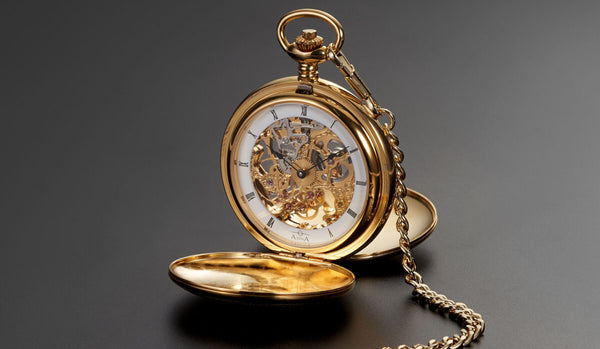
Mechanical watches are very sought-after timepieces, particularly for avid collectors that appreciate the intricate designs and craftsmanship of traditional timepieces. While mechanical watches might lack the connectivity of the smart watches and some digital technologies that are present in many wristwatches of the 21st century, their popularity is much more driven by sentimental value rather than performance, and in this way, mechanical watches are revered by people that collect them as a hobby or investment.
Mechanical watches require regular maintenance and cleaning, our watchmakers recommend servicing a mechanical watch every 3-5 years for optimum functionality. A well-maintained mechanical manual winding Adina watch can last for generations.
Automatic Watches
Automatic watches, also known as self-winding watches, use the natural motion of the wearer’s wrist to wind its mainspring and keep it running. They have been around for centuries but it wasn’t until the early 20th century that automatic movements in watches became more widely popular. And of course well before the first Adina (made still under the Rolma brand) Automatic watch came to life in 1971.
Automatic watches have a rotor, which is a metal weight that swings back and forth as the wearer moves their wrist. This motion transfers energy to the mainspring, which powers the watch. Our Amphibian, Oceaneer, Kensington and Country Master collections all feature at least one automatic model.
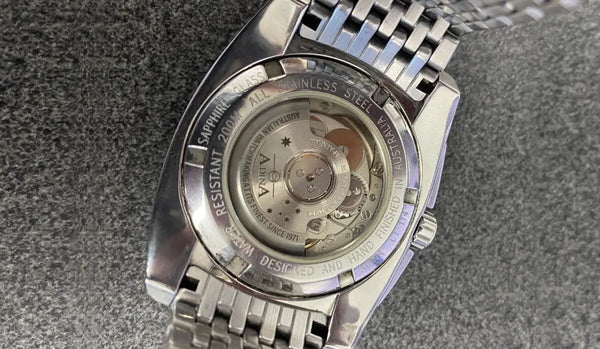
Automatic watches are typically more expensive than quartz watches, this is also true of our Adina automatic watch collection. In saying that many people still prefer the traditional mechanical feel of an automatic watch and of course, the prestige that goes with it!
The accuracy of automatic watches can be affected by factors such as temperature, magnetism, and the position of the watch so it’s important to keep them away from strong magnetic fields and to store them in a stable, cool environment.
Automatic watches as with their mechanical counter-parts require servicing typically every 3-5 years to ensure that they continue to function properly and maintain accuracy. Again, if you look after your Adina automatic watch and keep it well maintained, they can last for generations!
Mechanical Watches | Manual vs Automatic
Both manual and automatic mechanical watches are known for their traditional, sophisticated styles and durability.
Choosing between a manual or automatic mechanical watch will come down to personal preference and knowing what you value. Automatic watches are often more convenient for those who don’t want to manually wind their watches, while manual mechanical watches may appeal to those who appreciate the traditions and craftsmanship associated with a manually wound watch.
Automatic watches tend to be more common in modern watch designs and they certainly dominate the marketplace for mechanical watch varieties. Manual mechanical watches on the other hand have much more vintage or classic influences associated with them, and they only have a small market share here at Adina and can only be found in our Oceaneer collection.
Ultimately, the choice between an automatic and a manual wound mechanical watch will depend on individual style, aesthetics, and preference more so than function, as both watch movements operate with similar accuracy. If we had to choose though, we would recommend an automatic Adina over its manual sibling purely out of convenience.
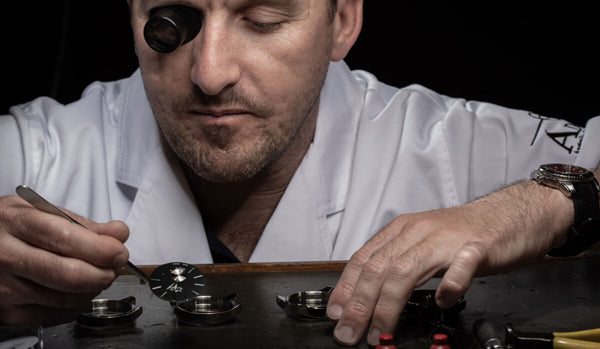
Craftsmanship & Tradition
Both automatic and mechanical Adina watches are crafted with intricate mechanisms that require precision and expertise to create. This craftsmanship is appreciated by many watch enthusiasts who appreciate the artistry and skill that goes into creating a mechanical watch movement.
Well-maintained automatic and mechanical watches can last for decades, even centuries, making both Adina watch types a valuable sentimental inheritance filled with memories.
A look through horological history will tell us that the mechanical watch is the prototype of all watches. The first watch movement ever created was the verge escapement, a mechanical watch that used a toothed wheel called a verge and a spring-loaded lever called a foliot to regulate the movement of the watch. In its time, the verge escapement was a breakthrough in horology and although it was not particularly accurate and required frequent adjustment, this mechanical watch was as a masterpiece.
Over time, other types of watch movements were developed, each one building upon and improving upon the design of the previous ones. The automatic watch was an adaption of the mechanical watch.

Movement & Power
Both Automatic and manual winding mechanical watches do not require batteries, which means they will keep running as long as they are regularly worn or wound. This eliminates the need to replace batteries and reduces waste. They could also be described as the ultimate in sustainability when it comes to watches. A true green solution for time keeping.
An Adina automatic watch has a power reserve of around 40 hours but can be kept running indefinitely as long as they are worn regularly, and the rotor is able to wind the mainspring. All Adina automatic watches have a manual winding function as well, which allows the wearer to wind the mainspring manually if the watch hasn’t been worn for a period.
Mechanical watches on the other hand typically have a power reserve of around 30 hours meaning that they can run for that length of time without needing to be wound up again.
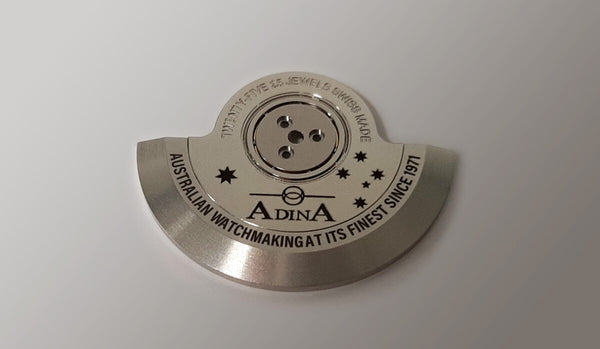
Function & Accuracy
The accuracy of a watch’s movement depends on several factors that include the quality of the movement, the frequency of use, and the watch’s maintenance. All Adina mechanical watches prior to shipping are regulated to +/- 8 seconds per day.
Both automatic and mechanical movements can be highly accurate, but automatic movements have an advantage in terms of accuracy due to there always being power on the mainspring whereas a manual watch will wind down over the course of the day and slow as the mainspring carries less and less power.
Automatic movements, also known as self-winding movements, are designed to use the natural motion of the wearer’s wrist to wind the watch and keep it running. This constant winding can help maintain a more consistent level of accuracy over time if the watch is worn regularly.
Mechanical movements require manual winding and can be more susceptible to variations in accuracy if not wound consistently. However, high-quality mechanical movements can still be highly accurate, especially if they are properly regulated and maintained.
Automatic and mechanical watches are not as accurate as quartz watches, but they are still highly accurate and are often preferred by watch enthusiasts who appreciate the slight variations in timekeeping that are inherent in mechanical watches.

Comparing Watch Movements
There are 3 types of Swiss watch movements that we use and all function quite differently: mechanical (manual winding) watch movements, automatic (self-winding) watch movements, and quartz watch (battery powered) movements. All 3 watch types have different mechanisms for keeping time and as a result, their lifespans can vary.
Quartz Adina watches use a battery to power a quartz crystal oscillator that regulates the timekeeping mechanism in the watch. These watches are generally very reliable and accurate, and they can last for many years with proper care and maintenance.
The lifespan of a quartz watch will depend on various factors including the quality of the watch case, how often it is worn, and how well it has been maintained. Generally, a well-maintained quartz watch can last for 10-20 years before needing major repairs. Adina quartz watches are considered the most preferred watches for affordability and everyday wear.
Automatic and mechanical watches on the other hand as discussed, rely on mechanical movements for their operation. Due to their reliance on more complex structures and moving parts, automatic and mechanical watches require more maintenance and care than quartz watches during their lifespan. With proper maintenance and care these types of watches can last for decades or even generations.
Overall, the popularity of automatic or manual mechanical Adina watches can be attributed to their craftsmanship, longevity, tradition, self-sustainability, and accuracy.
In comparing automatic and manual mechanical watches the choice to purchase one over the other comes down to individual preference, lifestyle, and values. Both watch movements measure up in accuracy and function the only major difference becomes a question of purpose.

Seaspray Jewellery stocks a wide range of Adina's watches and clocks however, if we don't have the exact style you are looking for you, we are happy to order Adina's other styles in for you!


